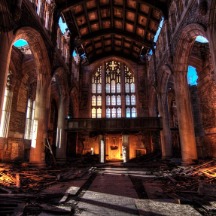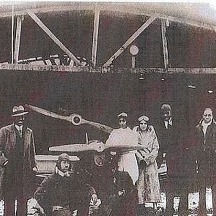The Calumet Region includes some of the most storied, but less known histories of African people in North America. The region was home of the Potawatomi and later became home of a mixture of people from Africa, Western and Eastern Europe, and Spanish-speaking countries. Today, it is home to one of the largest concentrations of African people in the world.
A diverse group of storytellers will speak at the 21st Annual Calumet Heritage Conference about their efforts to save and interpret the Calumet Region's heritage, as well as help us to understand the stories of those who built the Calumet Region into an industrial giant with a core of steel, minerals, and chemicals production. The storytellers will also focus on the living landscape now inhibited by the people living in the Calumet, which stretches around Lake Michigan from Chicago’s South Side, across the Illinois/Indiana line into Gary and portions of Northwest Indiana.
Conference attendance is free, but registration is required. Registration automatically includes access to all sessions. Zoom links will be sent via email prior to each session. The conference is Saturday, October 17, 2020 at 10a CDT to Thursday, October 22, at 8p CDT
Here is an abbreviated list of programs:
Saturday, October 17th
10:05 A.M. CDT- Session 1: Keynote, "From 'Seaman's Folly to Aesthetic Folly? The Transformation of Gary's City Methodist Church"
Moderator: Mario Longoni, Field Museum
Presenter: Dr. Renee Conroy, Purdue University Northwest
When does a crumbling structure become a genuine ruin? Various theoretical positions will be tested by sustained consideration of the complex case of Gary's City Methodist Church, an iconic heritage site in the Calumet region currently slated to be transformed from a paradigmatic Rust Belt ruin into a Romantic ruins garden.
Background Article: Gary Lands Grant Funding to Turn City Methodist Church into a Ruins Garden
The 21st Annual Calumet Heritage Conference


Tuesday, October 20th
6:30 P.M. CDT - Session 1: Gary's Artesian Well: The Spring at Small Farms
Moderator: Michael Longan, Valparaiso University and CHP Board Member
Presenter: Kay Westhues, Associate Faculty, Ernestine M. Raclin School of the Arts, Indiana University South Bend.
The spring at Small Farms is a public artesian well that supplied drinking water to families who lived in Small Farms and Black Oak, two rural communities now located in the city limits of Gary, IN. Small Farms was an historically Black community that was established during the Great Migration; Black Oak contained (and still has) a majority-white population. For approximately three decades, residents from both neighborhoods gathered water from the spring because of unreliable or contaminated in-his-hands wells and a lack of public water mains in the area. This presentation will explore the history of the spring, informed by oral histories and archival research, and examine why and how it has remained a public commons resource.
7:30 P.M. CDT - Session 2: The True Beginnings of The Tuskegee Airmen and Robbins' Historic 1931 Airport
Moderator: Tom Shepherd, CHP Board Member
Presenter: Tyrone C. Haymore, Co-Founder, Director and Historian for the Robbins History Museum
The historic all-Black 1931 Robbins Airport & Aviation School built in Robbins, Ilinois, is the first such in American history. It was built and operated by John C. Robinson and Cornelius R. Coffey. John C. Robinson has now officially been named "The Father of the Tuskegee Airmen" and the Ethiopian Air Lines. Both men were born the same year that aviation was born, in 1903. Both were reared and schooled in Mississippi and Arkansas. Both men met in Detroit as auto-mechanics and decided, following Bessie Coleman's death, to enroll in the segregated Curtiss Wright Aviation School in Chicago. They became the first African Americans to graduate from this school as aviation pilots and mechanics, and started their own aviation school in Robbins, IL 1931, with the help of two female student Willa Brown and Janet H. Bragg who were among their first students to complete their aviation training as pilots.
Background Article: Robbins Gave African-Americans Access to the Skies
6:30 P.M. CDT - Session 1: Gary's Artesian Well: The Spring at Small Farms
Moderator: Michael Longan, Valparaiso University and CHP Board Member
Presenter: Kay Westhues, Associate Faculty, Ernestine M. Raclin School of the Arts, Indiana University South Bend.
The spring at Small Farms is a public artesian well that supplied drinking water to families who lived in Small Farms and Black Oak, two rural communities now located in the city limits of Gary, IN. Small Farms was an historically Black community that was established during the Great Migration; Black Oak contained (and still has) a majority-white population. For approximately three decades, residents from both neighborhoods gathered water from the spring because of unreliable or contaminated in-his-hands wells and a lack of public water mains in the area. This presentation will explore the history of the spring, informed by oral histories and archival research, and examine why and how it has remained a public commons resource.
7:30 P.M. CDT - Session 2: The True Beginnings of The Tuskegee Airmen and Robbins' Historic 1931 Airport
Moderator: Tom Shepherd, CHP Board Member
Presenter: Tyrone C. Haymore, Co-Founder, Director and Historian for the Robbins History Museum
The historic all-Black 1931 Robbins Airport & Aviation School built in Robbins, Ilinois, is the first such in American history. It was built and operated by John C. Robinson and Cornelius R. Coffey. John C. Robinson has now officially been named "The Father of the Tuskegee Airmen" and the Ethiopian Air Lines. Both men were born the same year that aviation was born, in 1903. Both were reared and schooled in Mississippi and Arkansas. Both men met in Detroit as auto-mechanics and decided, following Bessie Coleman's death, to enroll in the segregated Curtiss Wright Aviation School in Chicago. They became the first African Americans to graduate from this school as aviation pilots and mechanics, and started their own aviation school in Robbins, IL 1931, with the help of two female student Willa Brown and Janet H. Bragg who were among their first students to complete their aviation training as pilots.
Background Article: Robbins Gave African-Americans Access to the Skies
Advertisers | Contact Us | Events | Links | Media Kit | Our Company | Payments Pier
Press Room | Print Cover Stories Archives | Electronic Issues and Talk Radio Archives | Writer's Guidelines






